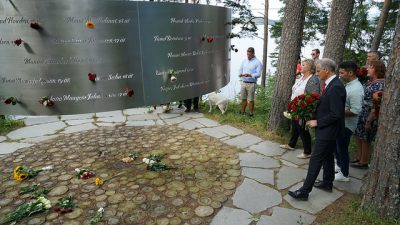Quieter, less elaborate memorials were held over the weekend for victims and survivors of attacks by an ultra right-wing nationalist who killed 77 people in Norway on July 22, 2011. Prime Minister Erna Solberg stresssed, however, that it was important to show that neither the victims, the survivors nor their families are forgotten.

“For us, the 22nd of July is a date that will always be connected to fear, despair and sorrow,” Solberg said in a brief speech during the national morning memorial ceremony. It was held, as in earlier years, outside the government complex in downtown Oslo that was heavily damaged by the right-wing terrorist’s homemade bomb. Eight people were killed in the bombing, before the terrorist moved on to the Labour Party’s youth summer camp on the island of Utøya, where he unleashed a massacre that killed 69 mostly young people and wounded scores of others. He blamed Labour for allowing, in his opinion, too many foreign immigrants to settle in Norway.
“Seeing that the rest of society hasn’t forgotten is important, I think, for those left behind,” Solberg continued. “For them, July 22nd will always be a painful day that will never go away, but it’s important to show that the entire country thinks about them, and that’s what this memorial does.”
Local ceremones were also being held in Bærum, Eidsvoll, Stryn, Trondheim, Tromsø and many other communities around the country. Most were modest in nature this year, marked by short speeches and simple wreath-layings.

Present at the ceremony were leaders of the national support group for survivors, leaders of the Labour Party that was attacked, and the Labour-led government at the time. Solberg’s predecessor as prime minister, the current secretary general of NATO Jens Stoltenberg, was also there, somber and in a dark suit and tie. He didn’t speak at the ceremony, but told reporters that he thinks the terror that struck Norway six years ago, and the country’s reaction to it, has helped other countries deal with terrorist attacks as well.
“Norway passed the test,” Stoltenberg told newspaper Aftenposten. “We showed that we had the ability to embrace democracy and openness. The rose parades and all the love and warmth people shown in the days following the attacks are what shapes our attitudes and values, and that’s important in the battle against terrorism.”
He pointed to similar reactions later in Manchester and Brussels, for example. “I know that other European leaders have looked to Norway and used Norwegian experiences when they experience terror themselves.”
While there’s been a nagging conflict over where to place a national monument to the victims near Utøya, the island itself already has a memorial with the names of all the deceased, and that’s where survivors and officials headed after the morning ceremony. There was more music and more speeches, by support group leader Lisbeth Røyneland, whose daughter was killed on Utøya, by the leader of the Labour’s youth group AUF, Mani Hussaini, and by Labour Party leader Jonas Gahr Støre, who was Stoltenberg’s foreign minister when the attacks occurred.

And there were more wreath-layings, with Solberg present again. The speeches all touched on lessons to be learned from the attacks, and how they’ll be explained to the next generation. Conversations with survivors, and what they experienced, are being preserved, for example, and shared at July 22 centers both on Utøya and at the government complex. It will be rebuilt, but already contains a memorial center that offers a straightforward account of what happened that Friday afternoon six years ago in Oslo and on Utøya.
Several films, plays and TV series are also being created around the attacks, much to the displeasure of AUF and many survivors. They think it’s too early to dramatize the tragedy, but don’t want to stand in the way of culture or spreading knowledge of the attacks. “It seems that the projects underway are being made with respect for those of us affected,” Røyneland told news bureau NTB.
Some survivors and victims’ families have said in recent weeks that they don’t want to “bother” others with their ongoing grief. While they still feel enormous pain, “we’re toning it down, too,” said the mother of one teenager killed on Utøya. “We’re afraid of plaguing folks around us with the trauma we still feel.” Psychologists caution that they still need help and support, and to be seen and heard. A survey conducted in 2015 revealed that half of all parents who lost children on Utøya were still unable to work full time.
“I’ve often thought that if my daughter had died in an accident, like in a bus crash on her way to Utøya, I could have understood it better,” Unni Espeland Marcussen told newspaper Dagsavisen late last week. “Accidents happen. What happened on July 22, that is not supposed to happen.”
newsinenglish.no/Nina Berglund

